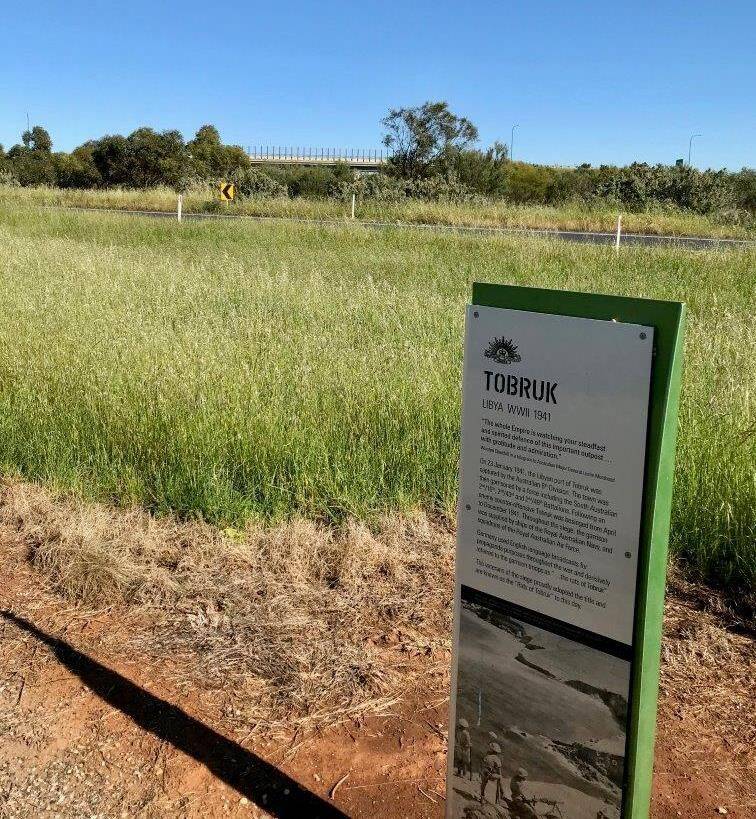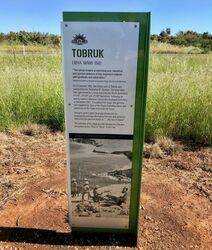
Home » Themes » Conflict » World War Two
Siege of TobrukPrint Page 
The bridge commemorates the Siege of Tobruk which occured in World War Two.
The Siege of Tobruk was a confrontation that lasted 242 days between Axis and Allied forces in North Africa during the Western Desert Campaign of World War Two. The siege started on 10 April 1941, when Tobruk was attacked by an Italo–German force under Lieutenant General Erwin Rommel.
Australians provided the mainstay of the Tobruk defence force until August, when they were withdrawn and replaced by the British 70th Division, with the attached Polish Carpathian Brigade. British forces lifted the siege on 10 December 1941 during Operation 'Crusader', when 1st Army Tank Brigade linked up with a 'break out' force from Tobruk - the 32nd Army Tank Brigade - at Ed Duda, to the south-east of the town.
The “Rats of Tobruk” was the name given to the soldiers of the garrison who held the Libyan port of Tobruk against the Afrika Corps during the Siege.
The garrison, commanded by Lieutenant General Leslie Morshead, consisted of the 9th Australian Division (20th, 24th, and 26th Brigades), the 18th Brigade of the 7th Australian Division, four regiments of British artillery and some Indian troops.
Five bridges along the Northern Expressway will be named in honour of some of Australia's most famous military battles. Premier Mike Rann this morning announced bridges along the expressway would be named after battles at Hamel, Tobruk, Kokoda, Kapyong and Long Tan. "Hamel, Tobruk, Kokoda, Kapyong and Long Tan are sacred places for all Australians, having helped shape the very future of our nation, they remain etched in our history forever," Mr Rann said.
Today's announcement follows the naming of the South Rd-Anzac Highway intersection as the Gallipoli underpass.
Returned and Services League state president Jock Statton praised the move. "It's a great opportunity to have these bridges named after significant battles," he said. "As with Anzac Highway, it's not the name of a service person there. "Here, it acknowledges all the people who have served in those conflicts and it will also acknowledge to the youth of today and the future of what Australia has been involved in."
Each bridge will have interpretive signs to help people to learn more about the battles.
The Advertiser (SA), 1 July 2010.
Location
| Address: | Northern Expressway & Heaslip Road, Penfield, 5121 |
|---|---|
| State: | Sa |
| Area: | AUS |
| GPS Coordinates: | Lat: -34.67939 Long: 138.623274 Note: GPS Coordinates are approximate. |
Details
| Monument Type: | Structure |
|---|---|
| Monument Theme: | Conflict |
| Sub-Theme: | WW2 |
| Actual Event Start Date: | 10-April-1941 |
| Actual Event End Date: | 10-December-1941 |
Dedication
| Approx. Monument Dedication Date: | Circa 2010 |
|---|
Plaque :
Tobruk
Libya WWII 1941
"The whole Empire is watching your steadfast and spirited defence of this important outpost... with gratitude and admiration." Winston Churchill in a telegram to Australian Major General Leslie Morshead
On 23 January 1941, the Libyan port of Tobruk was captured by the Australian 6th Division. The town was then garrisioned by a force including the South Australian 2nd / 10th, 2nd / 43rd and 2nd 48th Battalions. Following an enemy counter-offensive Tobruk was besieged from April to December 1941. Throughout the siege, the garrison was supplied by ships of the Royal Australian Navy, and Squadrons of the Royal Australian Air Force.
Germany used English language broadcasts for propaganda purposes throughout the war and derisively referred to the garrision troops as ".. the Rats of Tobruk".
The veterans of the siege proudly adopted the title and are known as the "Rats of Tobruk" to this day.






